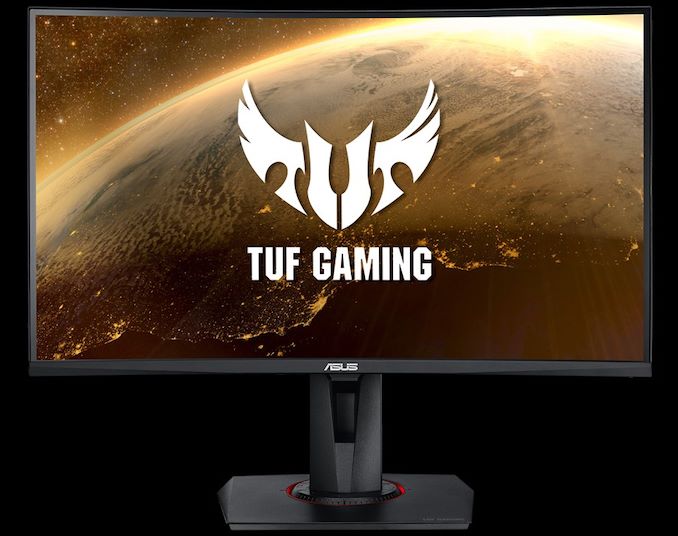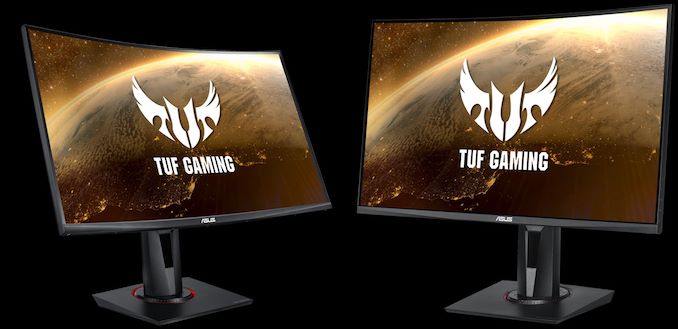Faster & TUFer Gaming: The ASUS VG27WQ 27-Inch 165Hz Curved Monitor w/ FreeSync
by Anton Shilov on December 9, 2019 6:00 PM EST- Posted in
- Displays
- Asus
- Monitors
- WQHD
- FreeSync
- TUF
- Curved Display
- TUF Gaming
- 165Hz

ASUS has introduced a new 27-inch curved display for its TUF Gaming brand of mainstream gaming monitors. The ASUS TUF VG27WQ is based on a 2560×1440 resolution curved VA panel featuring a relatively tight 1.5-meter radius (1500R) curvature, and offers 400 nits peak luminance, a 3000:1 contrast ratio, a 1 ms MPRT response time, and a maximum refresh rate of 165 Hz. Overall, TUF Gaming VG27WQ monitor is not focused on any particular feature (e.g., its maximum refresh rate), but rather ASUS is focusing on offering a combination of features in a resonably priced display.
This combination looks quite competitive. The monitor supports AMD’s FreeSync variable refresh rate technology with a very decent range between 48 Hz and 165 Hz. Furthermore, the display supports ASUS’s extreme low motion blur (ELMB) technology that promises to make fast-paced scenes look sharper. Last but not least, the monitor is DisplayHDR 400 certified, so it does support HDR10 transport (and a wider-than-sRGB color gamut) though its peak brightness is not really sufficient for a good HDR experience.
Like the rest gaming monitors from ASUS, the TUF VG27WQ supports GameVisual presets for different game genres (Scenery/Racing/Cinema/RTS/RPG/FPS/sRGB Modes/MOBA Mode) as well as GamePlus overlay enhancements designed to assist gamers (Crosshair/Timer/FPS Counter) in various situations.
Connectivity wise, the monitor has a DisplayPort 1.2 input, an HDMI 2.0 port, and a headphone output, which is good enough for PC gamers. The display is also equipped with two 2W speakers. As for ergonomics, the TUF VG27WQ comes with a stand that can adjust its height, tilt, and swivel. Alternatively, the monitor has VESA 100mm×100mm mounting holes.
| The ASUS TUF VG27WQ Monitor | ||
| TUF Gaming VG27WQ | ||
| Panel | 27" VA | |
| Native Resolution | 2560 × 1440 (16:9) |
|
| Refresh Rate | 165 Hz OC | |
| Dynamic Refresh Rate | Technology | AMD FreeSync |
| Range | DP: 48 Hz - 165 Hz HDMI 48 Hz - 144 Hz |
|
| Response Time | 1 ms MPRT | |
| Brightness | 400 cd/m² | |
| Contrast | 3000:1 | |
| Color Gamut | 120% sRGB | |
| Viewing Angles | 178°/178° horizontal/vertical | |
| Curvature | 1500R | |
| Inputs | 1 × DisplayPort 1.2 1 × HDMI 2.0 |
|
| USB Hub | - | |
| Audio | 2 W speakers | |
| Proprietary Enhancements | GamePlus: Crosshair/Timer/FPS Counter/Display Alignment GameVisual: Scenery/Racing/Cinema/RTS/RPG/FPS/sRGB Modes/MOBA Mode GameFast Input |
|
| Stand | Height | 120 mm |
| Tilt | +25° ~ -5° | |
| Swivel | +90° ~ -90° | |
| Power Consumption | Idle | 0.5 W |
| Typical | ? | |
| Maximum | 22 W | |
| MSRP | ? | |
Specifications of the ASUS TUF Gaming VG27WQ are already on the manufacturer’s website, though we do not know when the product is set to hit the market or at what price.
Related Reading:
- 28-Inches of TUF Gaming: The ASUS VG289Q 4K IPS Monitor w/ DCI-P3 & FreeSync
- AOC Reveals Agon AG273QX: A 27-Inch 165 Hz FreeSync 2 Monitor
- ViewSonic Introduces Elite XG270QG Monitor: WQHD w/DCI-P3 and 165 Hz G-Sync
- GIGABYTE’s Aorus CV27Q Curved ‘Tactical’ Monitor: 165 Hz QHD With FreeSync 2
- Dell Rolls Out 32-Inch QHD Curved Gaming Monitor (S3220DGF): Up To 165Hz with FreeSync 2
Source: ASUS (via Hermitage Akihabara)













16 Comments
View All Comments
lilkwarrior - Monday, December 9, 2019 - link
FFS: Can we get HDR beyond HDR10 in gaming monitors yet? Weird thing here is that Asus has stellar monitors w/ Dolby Vision & HLG released & coming up.crimsonson - Monday, December 9, 2019 - link
Dolby Vision requires 10-bit color depth, which requires more bandwidth. Variable sync further increases bandwidth demand.The display must also reach at least 600 nits to be DV compliant.
So you will have increased cost for the hardware needed for Dolby V + Variable Sync and licensing (Dolby).
At this level, there is not much difference between DV and HDR10 other than dynamic metadata. HLG is there for backward compatibility for SDR so doesn't really make any sense to add to gaming monitors.
Alistair - Monday, December 9, 2019 - link
For example at 120hz, my LG OLED can only do 1080p for Dolby Vision but it can do 1440p in HDR10.imaheadcase - Tuesday, December 10, 2019 - link
Not sure why you would even want that on a gaming monitor, but ok.uefi - Monday, December 9, 2019 - link
Why is it curved at 27"? Is it for people who position their faces two feet from the screen?ballsystemlord - Monday, December 9, 2019 - link
Oh, you mean like me? :)RobinRosengren - Tuesday, December 10, 2019 - link
Did you mean inches? Two feet from a monitor is nothing extreme.dullard - Tuesday, December 10, 2019 - link
The 1500R curvature is for people who sit up to 1.5 meters (up to 4.9 feet) from the monitor. They certainly could have curved it more for better viewing. But, I bet they would think that a strong curvature would scare away buyers who don't understand the benefits of curvature.JoeyJoJo123 - Tuesday, December 10, 2019 - link
~95% of the VA high refresh rate desktop monitor sized panels are curved--they're obtained from the panel manufacturer curved and that basically dictates that those monitors would also be curved. In fact, for 27" 1440p high refresh rate VA, there are ONLY curved panels, no flat panels. You could get a flat panel, but you'd have to live with a lower pixel density and more expensive ~32" panel I believe.As to why AUO and the other panel manufacturers are making all these curved VAs, I don't know. Curved monitors have been notoriously the worst in terms of uniformity, it would probably be more complex to manufacture than flat panels, amongst other factors, but still, we only got curved VA panels.
https://www.tftcentral.co.uk/articles/monitor_pane...
mode_13h - Saturday, December 14, 2019 - link
I thought VA monitors are being curved specifically to counter their inferior off-axis fidelity. Otherwise, I agree with @uefi that there's no point in curving a 27". I've had a flat one for many years. I would prefer not to go curved until at least 32" (if we're talking desktop monitors).